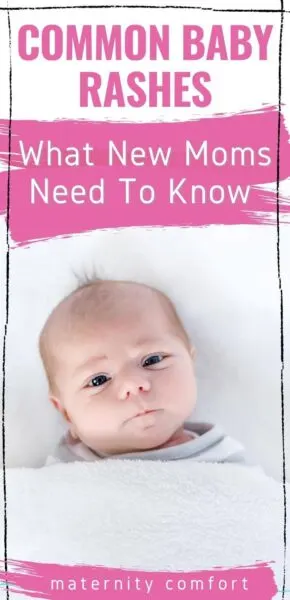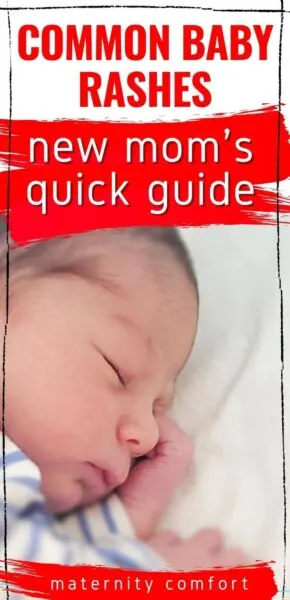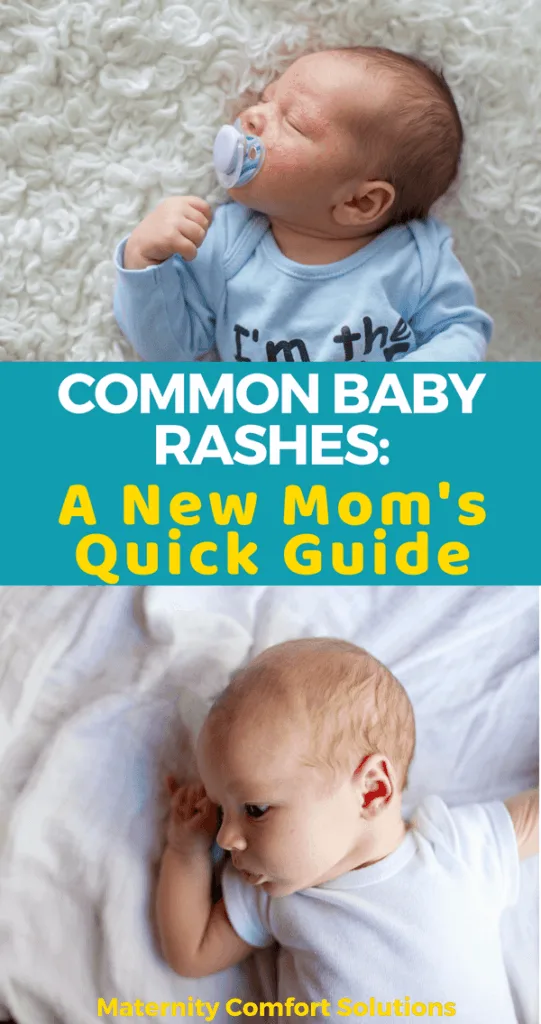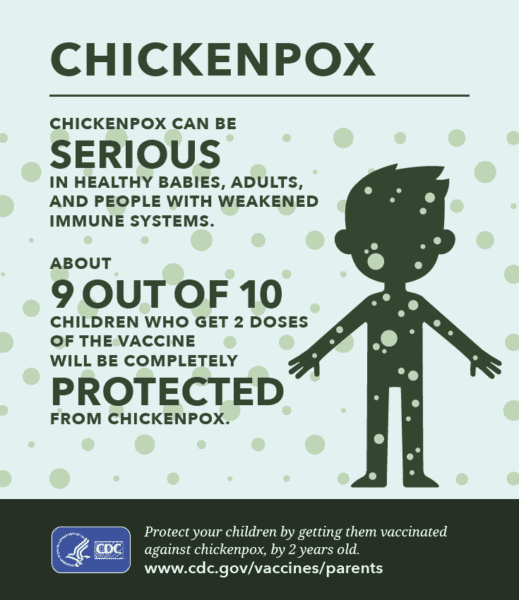As a new parent, you will deal with at least a few of these eleven common baby rashes.
The information in this article is intended to help parents and caregivers recognize some of the signs and symptoms associated with newborn rashes.
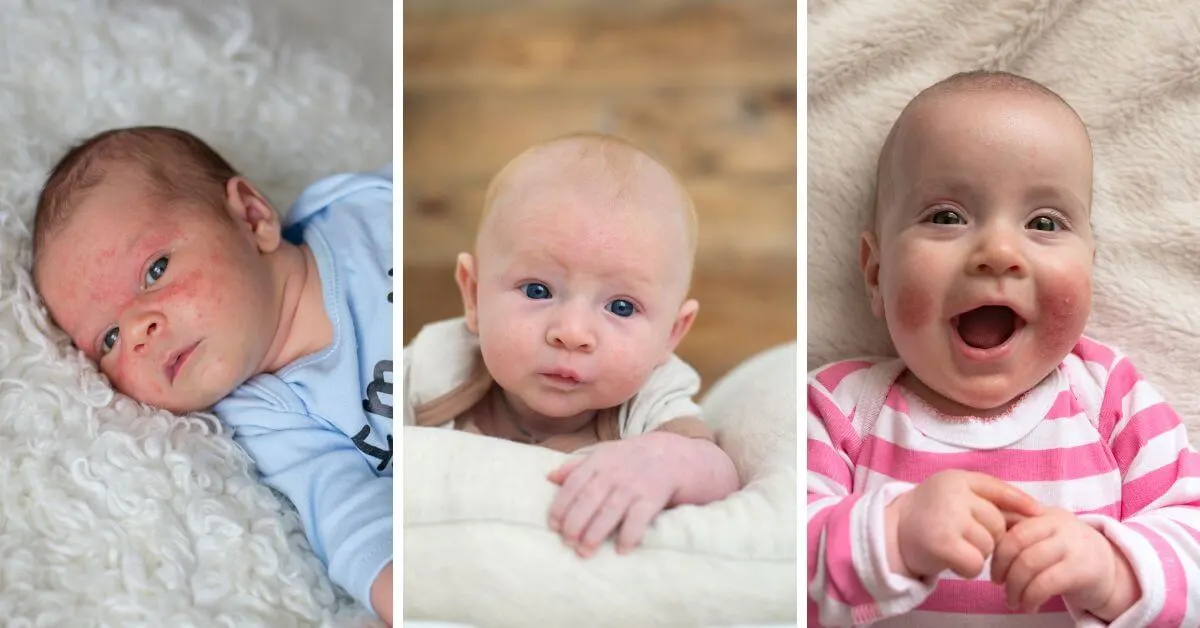
11 Common Baby Rashes:
1. Diaper Rash (Diaper Dermatitis):
When it comes to common baby rashes, diaper rash is likely the most prevalent among babies and toddlers.
The rash is caused by wet diapers, friction/rubbing, and food allergies.
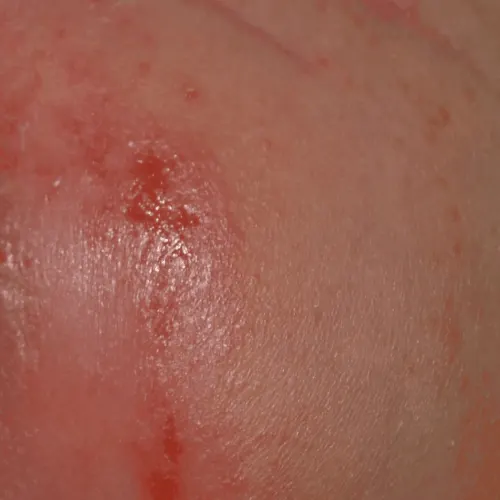
By Dailyboth [CC0], from Wikimedia Commons
A diaper rash makes the skin on the baby’s bottom look moist with flat red patches of skin.
The skin can become very red and irritated. Because of the moisture and irritation, a diaper rash will often cause a secondary yeast infection.
The best way to prevent diaper rash is to change your baby’s diaper frequently.
Check her diaper every two hours.
Make sure the area is clean and dry before putting on a clean diaper.
Use a diaper rash cream as a barrier to prevent irritation and exposure to wet diapers and to promote healing.
I have always used and sworn by Desitin diaper rash paste.
2. Prickly Heat Rash (Miliaria Rubra):
Prickly heat rash is common on hot and humid days.
The rash develops because your baby’s sweat glands and skin structures have not fully developed.
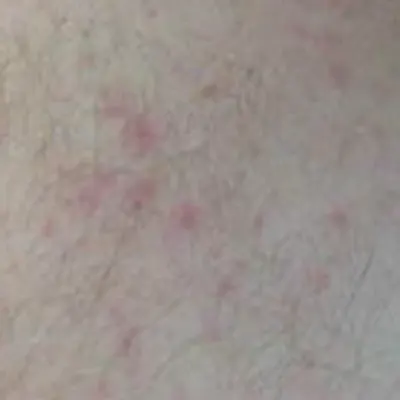
By Sentient Planet from Wikimedia Commons
On hot and humid days their sweat glands can get clogged which results in tiny red bumps on the face, folds of skin, or other covered areas of the skin.
The best way to prevent prickly heat rash is to dress your baby in light and loose clothing, give cool baths and use air conditioning or a fan to keep your baby’s skin cool and sweat-free.
3. Baby Acne:
Baby acne is a skin rash believed to be caused by exposure to maternal hormones during pregnancy.
It usually appears in the first 4 weeks after birth and can last until about 4 months of age.
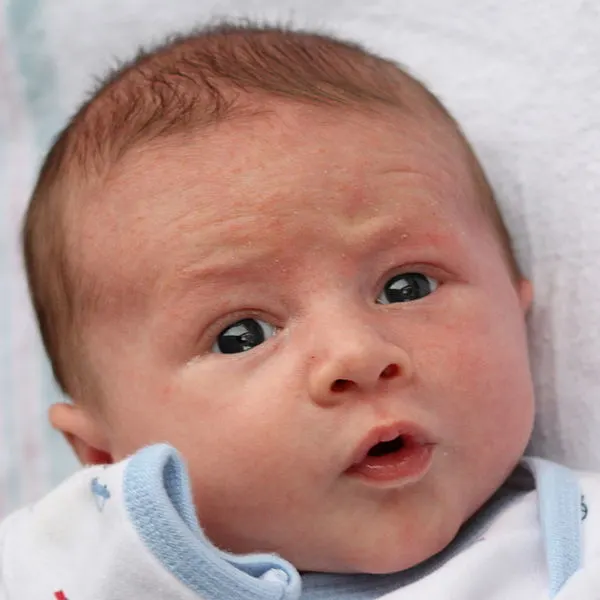
By Sage Ross from Wikimedia Commons
The rash is most often located on the face and forehead and appears as small red pimples with whiteheads. Fortunately, since baby acne is related to maternal hormones, it will disappear as the circulating hormones diminish.
Treating baby acne usually doesn’t require a trip to the pediatrician.
It can usually be treated at home by washing the affected area with a mild, gentle soap.
If the rash doesn’t clear up by 4 months of age, you may want to discuss it with your pediatrician to see if further treatment is necessary.
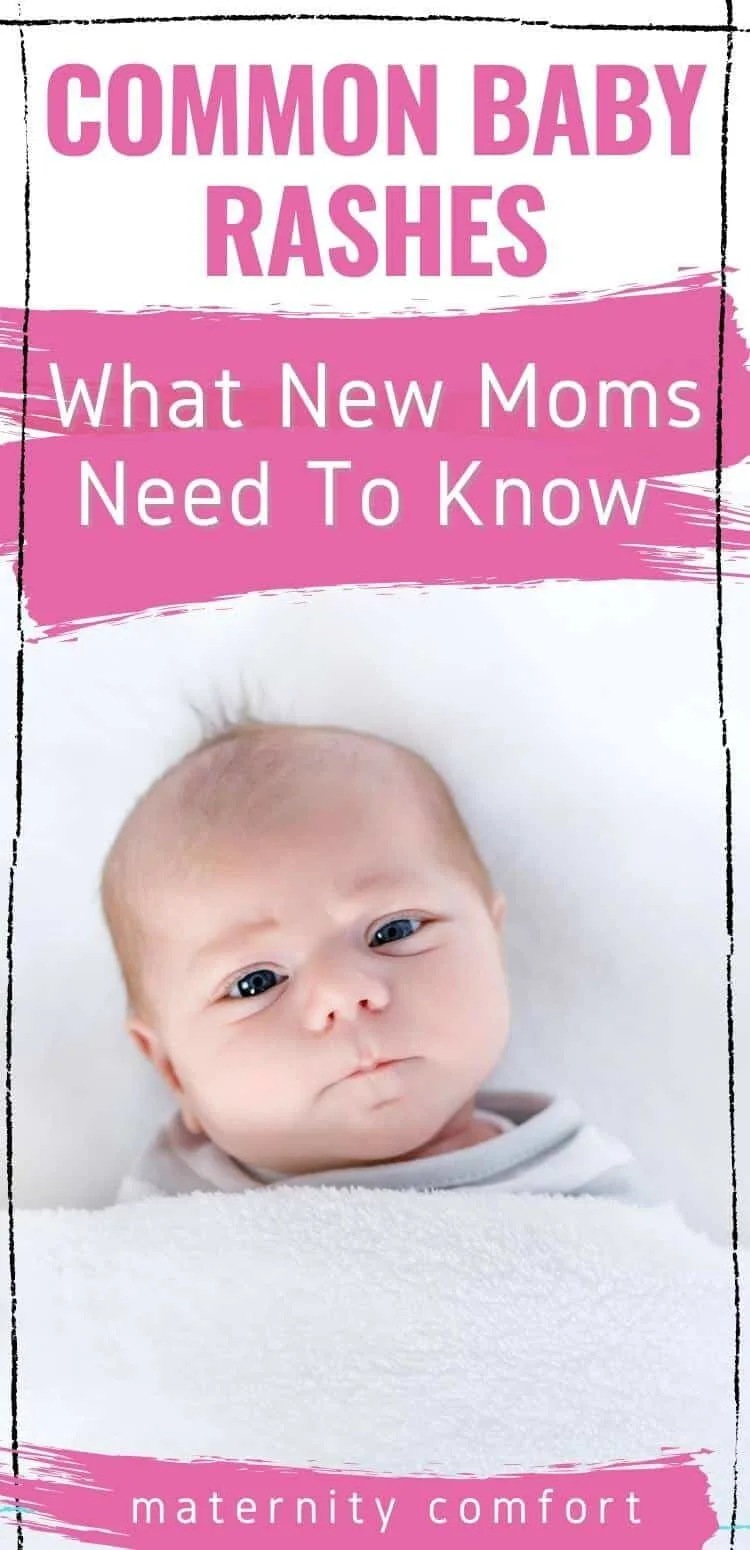
4. Scarlet Fever Rash:
Scarlet fever is an illness caused by the same bacteria that causes strep throat. Your baby will usually have a sore throat and high fever too.
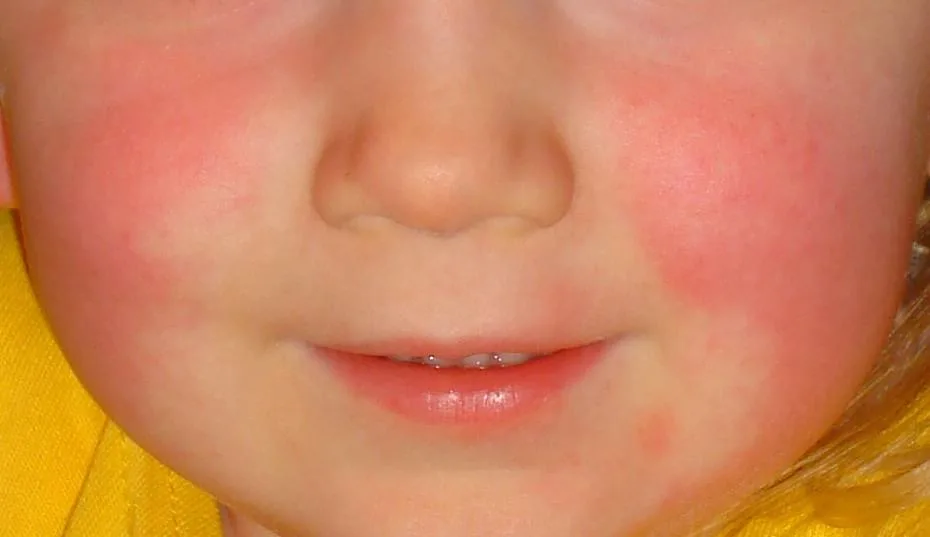
By Estreya at English Wikipedia
The rash is bright red and can look like a sunburn.
It usually covers most of the body. You may see a darker red area in the skin folds of the armpits, neck, and groin. Some children may have a “strawberry tongue”.
The tongue will look red and bumpy and may have a white coating on it.
Prevention involves keeping your baby away from people who may have strep throat.
Strep throat is easily spread from person to person.
Treatment requires a trip to the doctor and antibiotics.
5. Chicken Pox (Varicella):
Chickenpox used to be a common illness in childhood.
Fortunately, the rate of Chickenpox infections dropped dramatically as children started to receive the Varicella vaccine in 1995.
The incubation period is 11-20 days.
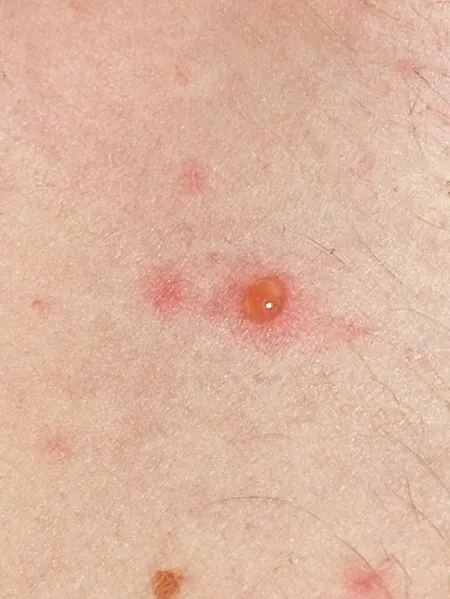
By F Malan from Wikimedia Commons
The rash is characterized by itchy red blisters that get crusty and scab over.
The incubation period is 11-20 days and varicella is contagious for about 4-5 days after the first blister appears. Recovery takes 7-14 days for most children.
If your child gets chickenpox, contact your pediatrician.
You want to obtain the most current information available to manage the rash until your child’s immune system has made antibodies to fight off the infection.
6. Measles (Rubeola):
Measles is included among the most common baby rashes globally.
It is a highly contagious viral infection. It is the leading cause of death in children.
Measles is transmitted via direct contact with the droplets of an infected person. The incubation period is 7-12 days.
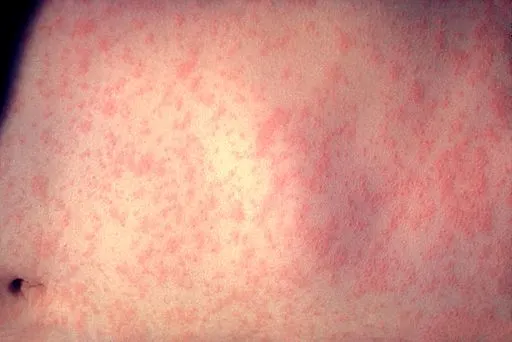
CDC/Dr. Heinz F. Eichenwald
The rash is generally widespread over the body and consists of red, itchy bumps.
Other symptoms include:
- Fever
- A Runny Nose
- Red Eyes
- A sore Throat
- A “Barking” Cough.
The rash usually subsides within 3-5 days.
Measles is prevented by being vaccinated with the MMR vaccine. Measles can cause life-threatening complications including encephalitis and pneumonia. Treatment involves comfort measures including rest and lots of fluids.
7. Erythema Toxicum Neonatorum (ETN):
This red rash can produce tiny white or yellow bumps. It is self-limited and can occur in healthy newborns.
The rash regresses in 5 to 14 days and requires no treatment. Once diagnosed, parents are given reassurance that it will resolve.
8. Hand Foot and Mouth (HFMD)
Hand-foot-and-mouth disease is caused by Coxsackievirus A.
It is most often contracted by children under 10 years of age and though it has unpleasant symptoms it is not a serious infection. As with many viral syndromes, it has to run its course.
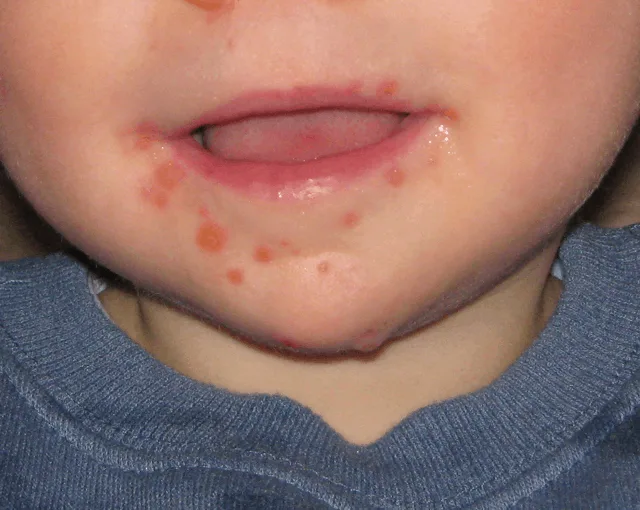
MidgleyDJ at en.Wikipedia from Wikimedia Commons
The symptoms include:
- Mouth ulcers or sores
- Rash or blisters involving hands, feet, legs, and buttocks
Treatment:
There is no treatment or vaccine for HFMD.
Typically it will last 7 to 10 days. Symptomatic relief is recommended in the form of acetaminophen, ibuprofen, and numbing mouth sprays.
Soothing relief for sore throats can be in the form of popsicles and smoothies.
9. Roseola (Sixth Disease)
Roseola causes 3-5 days of fever followed by a rash for 1-2 days.
It is very common.
Most children contract Roseola between 6 months and 2 years of age.
Roseola is also called exanthem subitum, and roseola infantum.
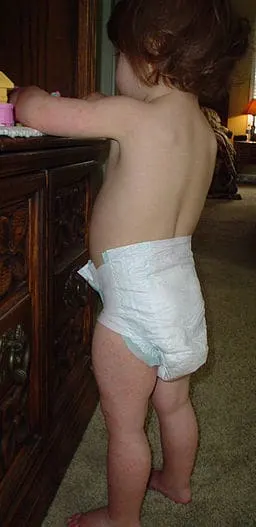
It is spread by respiratory (cough, sneeze) or direct contact.
The incubation period is 9 – 10 days. Roseola is caused by human herpesvirus 6 and 7.
A child can be contagious for up to two days after the fever subsides.
Signs and symptoms of roseola include:
- Abrupt onset high fever (103-104 degrees) lasting three to five days.
- Irritability S
- Swollen glands in the neck
- A Runny Nose
- Puffy Eyelids
- Mild Diarrhea.
- Rash 12-24 hours after fever breaks
Treatment:
- No treatment for the rash
- Fever can be high so fever reduction should be managed carefully with acetaminophen and ibuprofen. (Discuss fever management with your pediatrician. High fevers can result in febrile seizures.)
10. Cradle Cap Dermatitis:
Cradle cap is one of the more common baby rashes.
It is an inflammatory process and is a form of seborrheic dermatitis. Fortunately, it resolves with appropriate treatment.
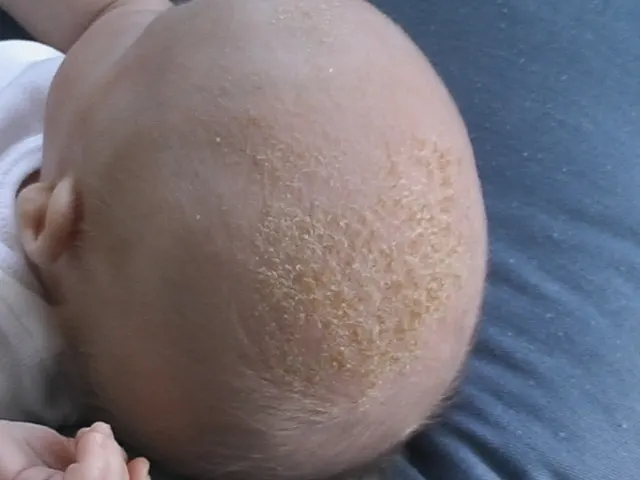
For new parents appears it can be concerning, presenting with crusty, yellow, greasy, scaling patches. However, the important thing is that it is not contagious and is not caused by poor hygiene,
Typically, it will clear up in 6 to 12 months.
The theory as to why it develops is because the baby’s oil glands are still being stimulated by circulating maternal hormones.
Treatment:
- Gently washing and combing hair.
- Lubricants such as vaseline, baby oil, and mineral oil.
- Don’t pick off the scales as this could cause irritation and lead to infection.
11. Eczema:
Eczema in newborns can present with itchy, thickened, dry, scaly skin. It can be similar to a cradle cap; however, it is a different condition, often seen on the face, elbows, and knees.
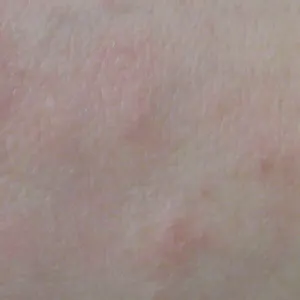
By James Heilman, MD from Wikimedia Commons
Eczema is also called atopic dermatitis. The most important point to keep in mind with eczema as a child or adult is to maintain adequate skin hydration. Hot showers or baths tend to dry the skin out.
Below are some measures you can take to treat newborn eczema.
Treatment:
- Lukewarm Bath
- Keep area clean and dry
- Moisturizers: Aveeno, Aquaphor by Eucerin, Cetaphil, Vaseline
- Two-thirds of children outgrow eczema.
What do teething rashes look like?
When a baby is teething, it’s not uncommon for them to develop a teething rash.
This can appear as red, raised bumps on the cheeks, chin, and gums.
Sometimes the rash may also appear on the chest or back.
In some cases, the rash may be accompanied by other symptoms such as drooling, fussiness, and a loss of appetite.
Teething rashes are usually nothing to worry about and will clear up on their own within a few days.
However, if the rash is accompanied by other symptoms such as fever or diarrhea, it’s important to see a doctor to rule out any other potential causes.
How do I know if my baby’s rash is serious?
It can be difficult to tell whether a rash is serious or not, especially when it comes to babies.
However, there are some general guidelines that can help.
First, it’s important to note that many rashes are harmless and will clear up on their own.
However, if the rash is accompanied by other symptoms such as fever, diarrhea, or vomiting, it’s likely a more serious issue and you should consult your pediatrician
Additionally, rashes that are spreading rapidly or appear to be getting worse should also be checked out by a medical professional.
Finally, any rash that is accompanied by swelling, redness, or pain is likely serious and requires prompt medical attention.
While it can be tricky to know for sure whether a rash is serious, following these guidelines can help you make the best decision for your baby’s health.
If you have questions about monkeypox and the risk to your baby you can find the most updated information on monkeypox from the CDC.
Other Articles You May Like:
- 10 Tips for Baby’s First Halloween
- 7 Must-know Tips for Traveling with Your Baby
- 5 Tips for Baby’s First Doctor’s Visit
Final thoughts
Although most rashes are nothing to worry about, it’s always important to be able to identify them just in case.
Knowing the different types of baby rashes and what causes them can help you feel more confident as a parent and help you deal with any potential rashes your child may have.
We hope this article was helpful and that you now feel better equipped to handle whatever skin issues come your way!

